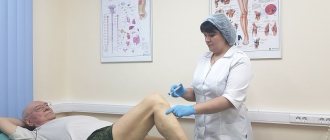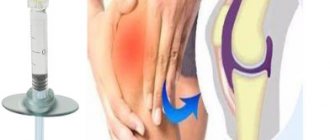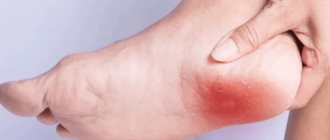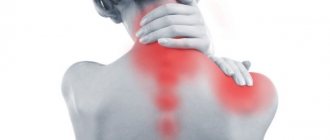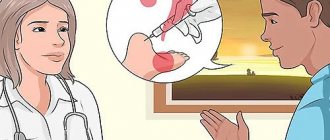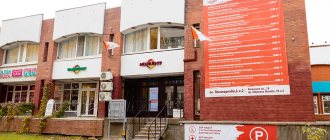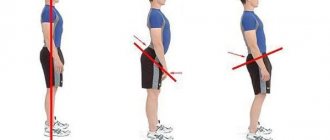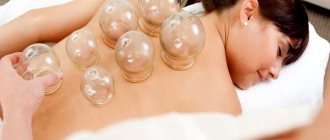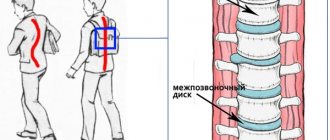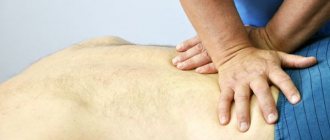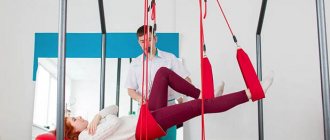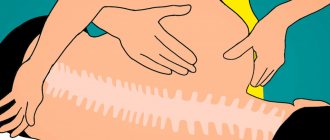Since many people have a diffuse form of the disease caused by an unhealthy lifestyle, exercise for osteoporosis is one of the important parts of treatment. Correct use of this method is quite capable of stimulating the restoration of skeletal strength.
The benefits of gymnastics for osteoporosis
Exercise therapy for osteoporosis should be selected carefully, taking into account the characteristics of the patient’s body and the current stage of development of his disease. The success of treatment is based on three main effects:
- Improved metabolism. Doctors have proven that the more a person moves, the less depletion of bone tissue. Moreover, with stable and regular loads, it even begins to build up - the skeleton gradually strengthens. Metabolic processes are stimulated both at the level of cells and tissues of the human body.
- Involvement of bone-forming cells. Therapeutic exercises for osteoporosis are designed to involve osteoblasts that for some reason have stopped functioning. The skeleton becomes stronger.
- Improving calcium absorption. It is for this reason that doing exercises is so important - without them, even the most well-designed diet will not give the desired effect - your body simply will not absorb the substances supplied to it.
Causes of the disease
About 99% of calcium in the body is concentrated in bone tissue. Since osteoporosis is defined by loss of bone mass, this is directly related to either insufficient calcium intake in the diet or abnormalities in the body that prevent it from being absorbed normally. The same culprit may be substances that promote calcium excretion.
Common sources of risk for the development and progression of the disease include:
- genetic predisposition. According to statistics, osteoporosis is much more common in women than in men. It is noted that the risk of the disease is higher among representatives of the Mongoloid and Caucasian races. Natural thinness of bones, short stature and low weight are important;
- hormonal imbalance (for example, menstrual irregularities);
- sedentary lifestyle;
- old age (usually the disease occurs in people over 60 years of age);
- hereditary factor;
- the presence of chronic diseases (renal failure, arthritis, type I diabetes mellitus, circulatory failure);
- strong physical activity;
- infertility;
- deficiency of vitamins A and D, phosphorus and other minerals;
- alcohol abuse (especially chronic alcoholism);
- insufficient consumption of meat and dairy products;
- long-term use of hormonal drugs;
- use of tobacco products.
Gymnastic complexes
Therapeutic exercise for osteoporosis is a complex compiled taking into account the patient’s condition. There is no need to try to group standard exercises on your own - this can cause harm rather than benefit. There are several important rules to consider during classes:
- All movements should be done smoothly. Sharpness and speed will not bring any effect - if you are already sick, then you need to be extremely careful when developing muscles and strengthening bones. If your doctor prescribes loads, increase them gradually. Even if it seems that something is too easy for you, it should be so.
- Follow the sensations. If something starts to hurt, you need to stop any exercise as soon as possible - your doctor may need to adjust the course.
- Physical education for osteoporosis should be strictly dosed and regular. You need to do at least 15 minutes of exercise a day and not give it up after some time.
- Don't forget about the right mood with which you approach training. You need to do the exercises voluntarily and have a good understanding of the effect they will have on your body.
Exercises for the spine
Therapeutic exercise for osteoporosis of the spine is aimed at preventing the disease from progressing - due to a fracture of the spinal column, you can remain disabled.
Most exercises are performed from a standing starting position, feet shoulder-width apart, back straight. The following types of gymnastics are practiced:
- walking with high knees;
- raising on toes and lowering on heels;
- bending the body to the side and other sides;
- bending the torso forward when the arms are raised and locked;
- raising your arms up.
All of the above can be considered a warm-up before the main part of the gymnastics complex. For the second part you will need to lie down. The lesson will be based on lifting up from your toes and bending your legs. Leg raises are also practiced while lying on your stomach. If you are lying on your side, swings are done.
Exercises for the hip joint
If exercise therapy for osteoporosis of the spine begins while standing, then for the hip joint you will need to lie on your back. The complex consists of several effective exercises:
- Lying on your back with your arms extended along your body, you need to raise and cross your straight legs.
- Lying on your back with your legs spread shoulder-width apart, you need to pull your socks towards you.
- Again, on your back, bend your knees and spread your arms out to the sides. Rest on your hands and roll your lower torso.
- From a supine position, gently and slowly bend your knees and bring them closer to your body as far as the stretch allows. You should not try to immediately reach your chest - it is dangerous.
Exercise therapy for hands
To perform such exercises you do not need to stand or lie down - any comfortable position will do. It is necessary to perform wrist rotations and bending. An important aspect is that you will need to monitor your body’s reaction. As soon as you feel pain, stop exercising immediately.
Classification of osteoporosis
There are several classifications of this disease, the most common of which is based on the etiological factor (the origin of the disease).
| Form of osteoporosis | Description of the disease |
| Primary osteoporosis | This form includes:
|
| Secondary osteoporosis | This form of the disease occurs as a result of another pathological disorder in the functioning of certain organ systems. The risk group includes people with diseases:
In addition to diseases, secondary osteoporosis can develop against the background of unfavorable conditions for the body (donor organ transplantation, immobilization, anorexia) or after prolonged use of certain medications (immunosuppressants, antibiotics, corticosteroids) |
Prevention of osteoporosis
Gymnastics for osteoporosis of the spine, if performed correctly, gives a good therapeutic effect. A well-designed load on the bone stimulates its strengthening and is necessary not only to combat the disease, but also to prevent it. Here are important tips to prevent illness:
- Exercise your muscles and bones regularly. Not strong, but sufficient to maintain tone.
- Use a special diet with a balanced composition.
- Spend more time outdoors.
- Maintain a normal sleep schedule.
- Consume vitamin complexes rich in calcium.
- Remember that it is better to prevent the development of a disease than to spend a lot of money fighting it.
Degree of development of osteoporosis
The disease can occur from the first to the fourth degree, let's look in detail at how this happens and what features exist in the various degrees.
1st degree
Despite the presence of the first degree, most patients do not observe any symptoms or special manifestations of pathology. At this stage, there is a slight decrease in bone density, which can only be determined through specialized medical research.
2nd degree
Although the disease progresses, it remains difficult to detect.
The bone tissue material undergoes thinning, the density decreases even more, but at the same time maintains the strength of the structure for the normal functioning of the patient.
3rd degree
The progress of pathological changes causes deformation of individual vertebrae, which is manifested by pronounced symptoms of the disease.
It is at the 3rd stage of development that the first bone fractures occur, indicating the presence of the disease.
4th degree
The bone tissues are severely destroyed; X-ray examination shows that their structure is almost “transparent”.
Minor loads cause severe pain in the patient. The risks of fractures and serious spinal injuries are maximum.
Exercises for osteoporosis of the spine for people under 50 years of age
- Take a starting position standing, lower your arms, keep your legs together. Inhale, raise your arms, and exhale, lower them. Repeat them five times.
- Stand straight, feet together, place your palms behind your head. Stretch up, rising on your toes, and lower your feet. Repeat four times.
- Starting position – standing, legs slightly bent at the knees, arms down. Raise your pelvis, hold it for 3-4 seconds, then smoothly lower it. Repeat ten times.
- The starting position is the same as in the previous exercise. Extend and contract your knees with tension. Do ten reps.
- Take a lying position on your back, stretch your arms down. Alternately press the back of your head, shoulder blades, then your arms, lower back, gluteal muscles, shins, and heels into the floor. Repeat 5-6 times.
- Lie on your back. Raise your shoulders and head 15-20 cm, stretch your chin to your stomach and lower yourself smoothly. Do this 3-5 more times.
- While lying on your back, smoothly lift your straight leg 15-20 cm, move it to the side, and lower it. Do this 10 times for each leg.
- Raise and lower your left leg 10 times while lying on your right side. Then lie on your left side and repeat the same for your right leg.
- Lying on your right side, slightly lift your two legs up and lower them smoothly. Lie on your left side and repeat the exercise. Do it 5 times.
- While lying on your stomach, stretch your arms down, lift them 10-20 cm above the floor, hold your legs straight for a few seconds, then smoothly lower them. Repeat 9 more times.
- While lying on your stomach, raise your straight, outstretched arms and hold them for a few seconds, then slowly lower yourself. Repeat 8 times.
- Take a sitting position on a chair, place your palms on your knees. Raise your arms up and stretch as you inhale, lower your arms as you exhale. Do 3-5 reps.
Prices
| Consultation with a doctor on the treatment of hip osteoporosis | From 500 rub. |
| First treatment cycle (12 sessions) | From 6,500 rub. |
| Second treatment cycle (12 sessions) | From 5,900 rub. |
| One lesson | From 700 rub. |
| General massage | From 1,000 rub. |
| Simple zonal taping | From 500 rub. |
| Combined zonal taping | From 800 rub. |
Based on the results of the consultation, diagnosis and/or treatment will be prescribed.
*Prices in different regions may vary; current information on the cost of services can be obtained from the center manager.
Treatment of osteoporosis of the hip joint
Osteoporosis affects the entire body. It occurs as a result of disturbances in the normal absorption of calcium. Osteoporosis is characterized by curvature of all bones, especially their heads in the joints, occasional and severe fractures, pain at rest and movement. The bones of the pelvis bear a lot of stress throughout life, and calcium loss in the bones here can be especially high. The processes of destruction of the hip joint often make a person disabled. Preventing such developments is the main task of the doctor.
Diagnosis by a doctor
Complex diagnostics makes it possible to determine at what stage of skeletal destruction the patient is. It is a great success for the patient and the doctor to identify the disease before the first fractures occur, since fractures of the pelvic bones are difficult to treat, and even more so with osteoporosis.
There is a special technique for determining the percentage of bone tissue density, in addition, an X-ray machine helps to identify existing defects in the bones. A blood test is required to determine the content of minerals and hormones. The final picture of the disease is established by a tomograph.
Disease prevention
If you have already crossed the forty-year mark, are involved in sports associated with the risk of fractures, have bad habits, were previously treated with immunosuppressive drugs, or have congenital skeletal diseases, you must understand that you are at risk and that it is better to prevent osteoporosis of the hip joint.
Review your diet, eat less heavy fats and more foods with vitamin D and minerals - dairy, greens, fish, grains, vegetable fats. If there is a lack of these products, you can use synthetic vitamin and mineral preparations.
Give a constant, but not excessive load on your skeleton, for which do aerobics, fitness, swimming, go to the gym.
Expose yourself to the sun more often to increase the production of vitamin D in your skin.
Visit your doctor from time to time for examination. Take steps to treat chronic metabolic diseases.
Sign up for a consultation
Prices in your city
Russia
- Russia
- Kazakhstan
- Azerbaijan
- Belarus
- Kyrgyzstan
- Latvia
- Uzbekistan
- Ukraine
Moscow
- Adler
- Almetyevsk
- Anapa
- Angarsk
- Arkhangelsk
- Astrakhan
- Balashikha
- Barnaul
- Belgorod
- Biysk
- Blagoveshchensk
- Bratsk
- Bryansk
- Vladivostok
- Vladimir
- Vologda
- Voronezh
- Grozny
- Ivanovo
- Irkutsk
- Yoshkar-Ola
- Kazan
- Kaliningrad
- Kaluga
- Kemerovo
- Korolev
- Kostroma
- Kotlas
- Krasnodar
- Kyzyl
- Leninogorsk
- Magnitogorsk
- Makhachkala
- Moscow
- Naberezhnye Chelny
- Nazran
- Nalchik
- Nizhnekamsk
- Nizhny Novgorod
- Novodvinsk
- Novokuznetsk
- Novosibirsk
- October
- Omsk
- Pavlovo
- Penza
- Permian
- Petrozavodsk
- Pskov
- Pushkino
- Rostov-on-Don
- Ryazan
- Samara
- Saint Petersburg
- Saransk
- Saratov
- Sarov
- Sevastopol
- Sergiev Posad
- Smolensk
- Sochi
- Stary Oskol
- Sterlitamak
- Tambov
- Tomsk
- Tula
- Tyumen
- Ulan-Ude
- Ulyanovsk
- Ufa
- Khabarovsk
- Khimki
- Chelyabinsk
- Yaroslavl
Select a branch
- m. Aviamotornaya - Moscow, st. Aviamotornaya, 10, building 2
- m. Academicheskaya - Moscow, st. Dm. Ulyanova, 31
- metro station Altufyevo - Moscow, Altufevskoe highway, 70, building 2
- m. Bagrationovskaya - Moscow, st. Novozavodskaya, 27A
- m. Belorusskaya - Moscow, 1st st. Yamskogo Polya, 24
- m. Boulevard Dm. Donskoy - Moscow, st. Feodosiyskaya, 2
- metro station Butyrskaya - Moscow, 17th proezd Maryina Roshchi, 4, building 1
- m. Kashirskaya - Moscow, Kashirskoe highway, 43, building 4
- Khodynka metro station, CSKA metro station, Polezhaevskaya metro station - Moscow, Berezovaya Roshchi passage, 12
What is the complexity of the combination of arthrosis and osteoporosis?
Even individually, each disease is very dangerous. If they complement each other, the clinical picture worsens. The bones that form the joint lose density, so the load on the cartilage increases - they wear out with triple the force. When experiencing pain due to arthrosis of the ankle, knee or hip joint, a person subconsciously moves less. Because of this, bone density rapidly decreases.
It turns out to be almost a vicious circle, which only an experienced orthopedist-rheumatologist can break. The earlier treatment is started, the better the prognosis, so you should seek help even if morning stiffness in the joint appears, without waiting for severe pain.
Arthrosis plus osteoporosis without treatment is almost certainly a rapid disability
Joint pain can indicate various diseases. How to react to it correctly and how to act in this case?
How to exercise correctly if you have osteoporosis? Basic recommendations
Exercise with osteoporosis should be done with great caution. In order for such activities to bring real benefits and not harm to health, it is very important to remember a few rules.
- Such training is contraindicated for people with chronic osteoporosis, as well as after recent fractures and in the presence of cancer . In any case, you can start exercising only after a thorough medical examination and with the permission of the attending physician . Considering that mature and elderly people (from 45-50 years old) who may also have problems with joints are more susceptible to the development of this disease, an experienced trainer or physiotherapist should be involved in drawing up an individual training program.
- It is strongly recommended that at least the first few sessions of physical therapy for osteoporosis be carried out under the guidance of a qualified specialist . Having mastered a set of basic exercises and thoroughly studied the technique of performing them, you can begin independent training.
- Remember that bone affected by osteoporosis is highly fragile and can break from any sudden movement. Therefore, all exercises must be performed slowly, measuredly and with a small amplitude . Each workout should begin with a light warm-up to prepare the muscles, joints and ligaments for work.
- Physical education for osteoporosis is a set of simple exercises, most of which are performed with static tension. This is the maximum load provided for this type of training. Under no circumstances should you use dumbbells, weights or barbells, or exercise on weight machines.
- It is unacceptable to violate the technique of performing exercises , since this can also lead to serious injuries.
- You can't exercise through pain . If performing an exercise causes the slightest discomfort, it must be replaced with an alternative one that works the same muscle group. If discomfort is observed even with minimal physical activity, you should immediately consult a doctor.
- It is necessary to attend classes only if you are fully mentally prepared . If a person is upset or depressed about something, this will invariably affect his physical condition. In a stressful situation, the muscles become tense and cannot properly perform a given amount of work. Therefore, if you are not in the mood, it is better to postpone the workout to another day.
- Physical therapy for osteoporosis will lose its effectiveness if carried out haphazardly. Classes should be held daily, for 15-20 minutes . If for any reason you missed a workout, you should not try to make up for lost time in one day, putting your health at unnecessary risk.
- Wear comfortable clothes and shoes . Forget about tight pants and T-shirts. Clothing should allow the body to breathe and not restrict movement, preventing the muscles from doing their job. It is better to choose shoes that have a low platform and fit tightly to the foot to provide the most reliable support.
- When performing exercises on the floor, use a special gymnastics mat or just a soft blanket to reduce pressure on the bones.
